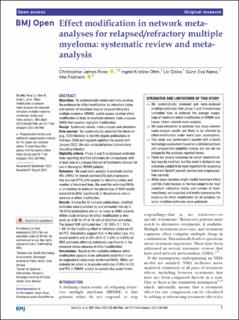| dc.contributor.author | Rose, Christopher James | |
| dc.contributor.author | Ohm, Ingrid Kristine | |
| dc.contributor.author | Giske, Liv | |
| dc.contributor.author | Næss, Gunn Eva | |
| dc.contributor.author | Fretheim, Atle | |
| dc.date.accessioned | 2023-11-28T06:55:53Z | |
| dc.date.available | 2023-11-28T06:55:53Z | |
| dc.date.created | 2023-08-30T11:19:08Z | |
| dc.date.issued | 2023 | |
| dc.identifier.citation | BMJ Open. 2023, 13 (8), 1-13. | en_US |
| dc.identifier.issn | 2044-6055 | |
| dc.identifier.uri | https://hdl.handle.net/11250/3104873 | |
| dc.description.abstract | Objectives To systematically review and meta-analyse
the evidence for effect modification by refractory status
and number of treatment lines in relapsed/refractory
multiple myeloma (RRMM); and to assess whether effect
modification is likely to invalidate network meta-analyses
(NMA) that assume negligible modification.
Design Systematic review, meta-analysis and simulation.
Data sources We systematically searched the literature
(e.g., OVID Medline) to identify eligible publications in
February 2020 and regularly updated the search until
January 2022. We also contacted project stakeholders
(including industry)
Eligibility criteria Phase 2 and 3 randomised controlled
trials reporting stratified estimates for comparisons with
at least one of a prespecified set of treatments relevant for
use in Norwegian RRMM patients.
Outcomes We used meta- analysis to estimate relative
HRs (RHRs) for overall survival (OS) and progression-
free survival (PFS) with respect to refractory status and
number of treatment lines. We used the estimated RHRs
in simulations to estimate the percentage of NMA results
expected to differ significantly in the presence versus
absence of effect modification.
Results Among the 42 included publications, stratified
estimates were published by and extracted from up to
18 (43%) publications and on as many as 8364 patients.
Within-study evidence for effect modification is very
weak (p>0.05 for 47 of 49 sets of stratified estimates).
The largest RHR estimated was 1.32 (95% CI 1.18 to
1.49) for the modifying effect of refractory status on HR
for PFS. Simulations suggest that, in the worst case, this
would result in only 4.48% (95% CI 4.42% to 4.54%) of
NMA estimates differing statistically significantly in the
presence versus absence of effect modification.
Conclusions Based on the available evidence, effect
modification appears to be sufficiently small that it can
be neglected in adequately performed NMAs. NMAs can
probably be relied on to provide estimates of HRs for OS
and PFS in RRMM, subject to caveats discussed herein. | en_US |
| dc.language.iso | eng | en_US |
| dc.rights | Navngivelse-Ikkekommersiell 4.0 Internasjonal | * |
| dc.rights.uri | http://creativecommons.org/licenses/by-nc/4.0/deed.no | * |
| dc.title | Effect modification in network meta-analyses for relapsed/refractory multiple myeloma: Systematic review and meta-analysis | en_US |
| dc.type | Peer reviewed | en_US |
| dc.type | Journal article | en_US |
| dc.description.version | publishedVersion | en_US |
| cristin.ispublished | true | |
| cristin.fulltext | original | |
| cristin.qualitycode | 1 | |
| dc.identifier.doi | 10.1136/bmjopen-2022-067966 | |
| dc.identifier.cristin | 2170852 | |
| dc.source.journal | BMJ Open | en_US |
| dc.source.volume | 13 | en_US |
| dc.source.issue | 8 | en_US |
| dc.source.pagenumber | 1-13 | en_US |

